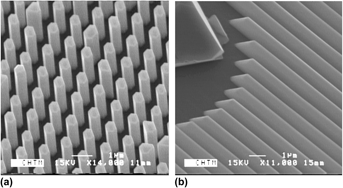Crossref Citations
This article has been cited by the following publications. This list is generated based on data provided by
Crossref.
Jacopin, G
Rigutti, L
Bellei, S
Lavenus, P
Julien, F H
Davydov, A V
Tsvetkov, D
Bertness, K A
Sanford, N A
Schlager, J B
and
Tchernycheva, M
2012.
Photoluminescence polarization in strained GaN/AlGaN core/shell nanowires.
Nanotechnology,
Vol. 23,
Issue. 32,
p.
325701.
Choi, Kihyun
Arita, Munetaka
Kako, Satoshi
and
Arakawa, Yasuhiko
2013.
Site-controlled growth of single GaN quantum dots in nanowires by MOCVD.
Journal of Crystal Growth,
Vol. 370,
Issue. ,
p.
328.
Rishinaramangalam, Ashwin K.
Fairchild, Michael N.
Hersee, Stephen D.
Balakrishnan, Ganesh
and
Feezell, Daniel F.
2013.
Three-dimensional GaN templates for molecular beam epitaxy of nonpolar InGaN/GaN coaxial light-emitting diodes.
Journal of Vacuum Science & Technology B, Nanotechnology and Microelectronics: Materials, Processing, Measurement, and Phenomena,
Vol. 31,
Issue. 3,
Shi, Jun Jie
Zhou, Tie Cheng
Zhong, Hong Xia
Jiang, Xin He
and
Huang, Pu
2013.
Light Emission Induced by the Indium Distribution in InGaN Nanowires.
Advanced Materials Research,
Vol. 815,
Issue. ,
p.
148.
Zhou, Tie-cheng
Shi, Jun-jie
Zhang, Min
Yang, Mao
Zhong, Hong-xia
Jiang, Xin-he
and
Huang, Pu
2013.
Band Edge Modulation and Light Emission in InGaN Nanowires Due to the Surface State and Microscopic Indium Distribution.
The Journal of Physical Chemistry C,
Vol. 117,
Issue. 31,
p.
16231.
Choi, Kihyun
Kako, Satoshi
Holmes, Mark J.
Arita, Munetaka
and
Arakawa, Yasuhiko
2013.
Strong exciton confinement in site-controlled GaN quantum dots embedded in nanowires.
Applied Physics Letters,
Vol. 103,
Issue. 17,
Urban, A
Malindretos, J
Klein-Wiele, J-H
Simon, P
and
Rizzi, A
2013.
Ga-polar GaN nanocolumn arrays with semipolar faceted tips.
New Journal of Physics,
Vol. 15,
Issue. 5,
p.
053045.
Tessarek, C.
Bashouti, M.
Heilmann, M.
Dieker, C.
Knoke, I.
Spiecker, E.
and
Christiansen, S.
2013.
Controlling morphology and optical properties of self-catalyzed, mask-free GaN rods and nanorods by metal-organic vapor phase epitaxy.
Journal of Applied Physics,
Vol. 114,
Issue. 14,
Tessarek, C
Figge, S
Gust, A
Heilmann, M
Dieker, C
Spiecker, E
and
Christiansen, S
2014.
Optical properties of vertical, tilted and in-plane GaN nanowires on different crystallographic orientations of sapphire.
Journal of Physics D: Applied Physics,
Vol. 47,
Issue. 39,
p.
394008.
Lin, Yen‐Ting
Yeh, Ting‐Wei
Nakajima, Yoshitake
and
Dapkus, P. Daniel
2014.
Catalyst‐Free GaN Nanorods Synthesized by Selective Area Growth.
Advanced Functional Materials,
Vol. 24,
Issue. 21,
p.
3162.
Musolino, M.
Tahraoui, A.
Limbach, F.
Lähnemann, J.
Jahn, U.
Brandt, O.
Geelhaar, L.
and
Riechert, H.
2014.
Understanding peculiarities in the optoelectronic characteristics of light emitting diodes based on (In,Ga)N/GaN nanowires.
Applied Physics Letters,
Vol. 105,
Issue. 8,
Tessarek, Christian
Röder, Robert
Michalsky, Tom
Geburt, Sebastian
Franke, Helena
Schmidt-Grund, Rüdiger
Heilmann, Martin
Hoffmann, Björn
Ronning, Carsten
Grundmann, Marius
and
Christiansen, Silke
2014.
Improving the Optical Properties of Self-Catalyzed GaN Microrods toward Whispering Gallery Mode Lasing.
ACS Photonics,
Vol. 1,
Issue. 10,
p.
990.
Fan, Shizhao
Zhao, Songrui
Liu, Xuedong
and
Mi, Zetian
2014.
Study on the coalescence of dislocation-free GaN nanowires on Si and SiOx.
Journal of Vacuum Science & Technology B, Nanotechnology and Microelectronics: Materials, Processing, Measurement, and Phenomena,
Vol. 32,
Issue. 2,
Ra, Yong-Ho
Navamathavan, Rangaswamy
Yoo, Hee-Il
and
Lee, Cheul-Ro
2014.
Single Nanowire Light-Emitting Diodes Using Uniaxial and Coaxial InGaN/GaN Multiple Quantum Wells Synthesized by Metalorganic Chemical Vapor Deposition.
Nano Letters,
Vol. 14,
Issue. 3,
p.
1537.
Chyi, Jen-Inn
Fujioka, Hiroshi
Morkoç, Hadis
Musolino, M.
Meneghini, M.
Scarparo, L.
De Santi, C.
Tahraoui, A.
Geelhaar, L.
Zanoni, E.
and
Riechert, H.
2015.
Deep level transient spectroscopy on light-emitting diodes based on (In,Ga)N/GaN nanowire ensembles.
Vol. 9363,
Issue. ,
p.
936325.
Fernández-Garrido, Sergio
Zettler, Johannes K.
Geelhaar, Lutz
and
Brandt, Oliver
2015.
Monitoring the Formation of Nanowires by Line-of-Sight Quadrupole Mass Spectrometry: A Comprehensive Description of the Temporal Evolution of GaN Nanowire Ensembles.
Nano Letters,
Vol. 15,
Issue. 3,
p.
1930.
Urban, A.
Müller, M.
Karbaum, C.
Schmidt, G.
Veit, P.
Malindretos, J.
Bertram, F.
Christen, J.
and
Rizzi, A.
2015.
Optical Emission of Individual GaN Nanocolumns Analyzed with High Spatial Resolution.
Nano Letters,
Vol. 15,
Issue. 8,
p.
5105.
Heilmann, Martin
Sarau, George
Göbelt, Manuela
Latzel, Michael
Sadhujan, Sumesh
Tessarek, Christian
and
Christiansen, Silke
2015.
Growth of GaN Micro- and Nanorods on Graphene-Covered Sapphire: Enabling Conductivity to Semiconductor Nanostructures on Insulating Substrates.
Crystal Growth & Design,
Vol. 15,
Issue. 5,
p.
2079.
Belyanin, Alexey A.
Smowton, Peter M.
Bhattacharya, Pallab
Deshpande, Saniya
Frost, Thomas
and
Hazari, Arnab
2015.
III-Nitride high temperature single-photon sources.
Vol. 9382,
Issue. ,
p.
938207.
Rishinaramangalam, Ashwin K.
Ul Masabih, Saadat Mishkat
Fairchild, Michael N.
Wright, Jeremy B.
Shima, Darryl M.
Balakrishnan, Ganesh
Brener, Igal
Brueck, S.R.J.
and
Feezell, Daniel F.
2015.
Controlled Growth of Ordered III-Nitride Core–Shell Nanostructure Arrays for Visible Optoelectronic Devices.
Journal of Electronic Materials,
Vol. 44,
Issue. 5,
p.
1255.
